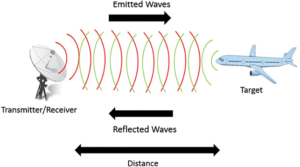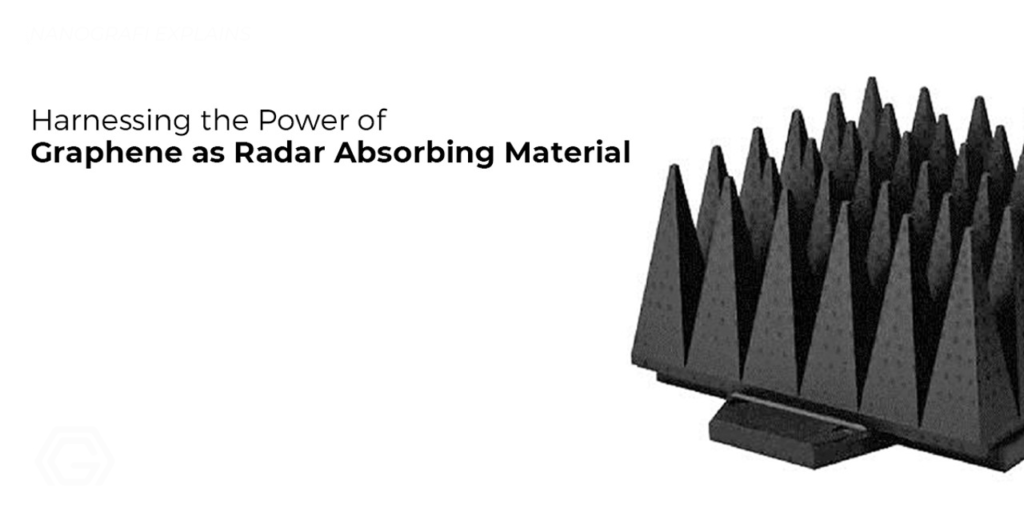The exceptional properties and predominant execution of graphene render it a promising radar retaining material, enthralling the interest of scientists and making a convincing inclination to dive into its potential applications.
Graphene, a solitary molecule thick material made out of carbon iotas, displays interesting electrical,mechanical, and warm properties. At the point when utilized as a radar retaining material, it gathers huge interest because of its elite presentation and great qualities. Graphene’s radar assimilation capacities originate from its capacity to limit the impression of electromagnetic waves by retaining them. With its low thickness, wideband retention, brilliant conductivity, and viability across an expansive recurrence range, graphene offers benefits in diminishing reflections and related reflection misfortunes in radar frameworks. At QuantoNano, our high level assembling cycles and ability permit us to convey graphene with extraordinary properties. To find additional data about graphene items, you can visit QuantoNano.
Introduction
Graphene exhibits high conductivity and broadband retention properties, as well as the capacity to cooperate with microwaves and diminish reflections, making it a promising material for microwave applications in correspondences and radar advances. These microwaves cover frequencies from one square millimeter to one meter. The utilization of resistive and metallic surfaces for microwave assimilation and free-space controlling, separately, presents provokes for dynamic microwave the board because of the requirement for huge versatile surfaces. Broad exploration means to accomplish electrically controllable microwave reflection and transmission, zeroing in principally on tuning microwave-matter connections by electrical techniques.
Versatile surfaces use materials with variable conductivity, permittivity or penetrability. Our proposition proposes to control surface charge fixation rather than mass material properties to control microwaves. Graphene, a 2D carbon precious stone with a very huge surface region, provides a promising stage for imaginative versatile microwave surfaces. Through electrostatic doping, molecularly meager layers empower the acknowledgment of changeable radar retention surfaces.
What is Radar-Retaining Material (RAM)?
Radar-retaining materials (Smash) are specifically planned materials that are utilized to diminish or dispose of the impression of electromagnetic waves. They utilize two fundamental methodologies:
- Absorption
- Multiple reflections.
the force of the waves and converts them into heat energy. Slam accomplishes this through various systems like ohmic misfortune, dielectric misfortune, or attractive misfortune, which are impacted by the material’s penetrability and complex permittivity.
Various reflections, otherwise called disastrous impedance, happen inside the Slam when approaching waves are reflected ever changing between the back and front countenances of the material. This peculiarity assists with limiting the general impression of the waves.
Slam plays a vital job in secrecy innovation, especially in lessening the radar cross-segment of military airplane and automated flying vehicles (UAVs). It is applied to different surfaces, including the outside skin and high-radar reflection regions like surface edges, to debilitate reflected announces retaining the electromagnetic wave energy.
Applications of Radar Engrossing Materials
The use of radar-engrossing materials (Slam) and designs in stealth technology, such as the use of these materials on the surfaces of the F-117 Nighthawk airplane by the US Aviation based armed forces, addresses one of the most notable utilizations of Smash. In any case, it is critical to take note of that RAS (Radar Retaining Designs) and Smash find applications not just in the military field yet in addition in business microwave correspondences systems. lately, Slam has likewise been utilized in business and common settings to moderate radar dissipating from huge structures situated close to air terminals, which might actually impede common flight radar frameworks. In addition, RAM is used in different buyer gadgets like recieving wires, vehicle radios, cell phones, and broadcast communications base stations.

Types of Radar Engrossing Materials
Radar-engrossing materials (Smash) include a scope of safeguards intended to limit the impression of electromagnetic waves. These safeguards assume a pivotal part in upgrading covertness capacities by decreasing radar wave reflection.
- Foam Absorbers: Froth safeguards, for example, carbon-stacked sheets and molded froth safeguards, come in various structures and are utilized to limit appearance in anechoic chambers.
- Elastomers: Elastomers are utilized as surface wave safeguards, while iron ball paint contains iron particles that convert radar energy into heat through atomic oscillations.
- Iron Ball Paint: Iron ball paint, which contains iron particles, lessens reflection by changing over radar energy into heat through sub-atomic oscillations.
- Low-recurrence Absorbers: Low-recurrence safeguards use formed attractive particles to accomplish successful reflection loss.
- Jaumann Absorbers: Jaumann safeguards work on the standard of wave obstruction to drop reflected signals.
- Tuned Recurrence Absorbers: Tuned recurrence safeguards display significant reflection misfortune at explicit frequencies.
- Cavity Reverberation Absorbers: Pit reverberation safeguards are intended for high misfortune in microwave cavities.
- Split-ring Resonators (SRRs): SRRs have shown superb execution as radar safeguards. These advances can be consolidated to upgrade retention capabilities.
Electromagnetic Standards of Radar Permeable Materials
Microwave radiation reflection control is significant in different situations. For instance, anechoic chambers, which mean to mimic free space in a restricted climate, require walls fixed with materials that retain electromagnetic waves. Additionally, in reconnaissance radar frameworks, strong return signals from adjacent articles like poles, structures, or extensions can restrict execution. Covering these articles with retentive layers can improve radar framework abilities. Japan is tending to TV “phantom pictures” brought about by signal reflections utilizing a comparative methodology. The military has additionally perceived the capability of microwave-retaining materials, for example, those utilized in the “Covertness” program, to lessen target detectability. Every utilization of radar retentive materials has exceptional electromagnetic prerequisites, with anechoic chambers requiring high ingestion across a wide recurrence range.
Planning safeguards includes considering factors like the climate, weight, size limits, and the particular factors that influence execution. Mathematical factors are vital because of the frequency size at microwave frequencies, and safeguards depend on mass electromagnetic properties. Commonsense electromagnetic safeguards should meet explicit circumstances and keep up with their exhibition over the pertinent recurrence band all through their functional life. This multidisciplinary field incorporates information on electromagnetic properties, underlying respectability, and compound arrangement. Significant electromagnetic basics incorporate material properties, reflection and refraction at limits, and impedance coordinating. By taking into account these perspectives, viable command over microwave radiation reflection can be accomplished in different conditions and applications.
Graphene as Radar Retaining Material
Graphene and its builds, for example, graphene oxide (GO) and diminished graphene oxide (rGO), have drawn in critical interest as microwave safeguard materials. Scientists have created porous progressive nanocomposites of CoFe2O4/rGO (CFO/rGO) utilizing an in situ solvothermal strategy. The EM qualities of the CFO/rGO composites were concentrated on by changing the example thickness and changing the weight % of rGO. The outcomes showed a viable transmission capacity of 5.8 GHz (8.3-14.1 GHz) and a microwave retention response at 10 GHz. The better impedance coordinating, dielectric misfortune, micropores in the CFO, and interfacial polarization add to the material’s weakening characteristics. Comparable examination on FeCoNiOx and PDA-rGO composites exhibited a greatest weakening of 36.28 dB with a 3.2 GHz powerful transmission capacity and a 6.5 mm thickness. These materials principally weaken electromagnetic waves through dielectric shortfall, while the attractive metallic parts improve impedance coordinating and energy misfortune.

The Advantages of Graphene Included Radar Obserbing Material
Graphene, as a radar-retaining material, offers a scope of advantages because of its special properties. Right off the bat, graphene exhibits remarkable electrical conductivity, permitting it to really assimilate and scatter electromagnetic waves. This outcomes in decreased radar reflection and upgraded covertness capacities. Moreover, graphene is lightweight and adaptable, making it reasonable for different applications, including covering surfaces of military airplane and automated flying vehicles (UAVs). Its meager and minimal design empowers consistent coordination into existing frameworks without compromising streamlined features. Besides, graphene-based radar-retaining materials have the potential for wide data transmission retention, covering an expansive scope of frequencies. This flexibility makes graphene a promising contender for cutting edge radar-engrossing materials, giving superior execution and effectiveness in radar frameworks. In general, the advantages of graphene as a radar-engrossing material lie in its high conductivity, lightweight nature, similarity with existing frameworks, and wide recurrence retention capabilities.
Graphene and Carbon Nanotube-based Composite Materials Properties for Slam
Graphene and carbon nanotube-based composite materials stand out for their true capacity in radar-retaining materials (Smash). These composites offer one of a kind properties that make them reasonable for Smash applications, like excellent electrical conductivity, mechanical strength, and flexibility. By consolidating graphene and carbon nanotubes, specialists expect to upgrade the radar-engrossing capacities of the composite, decreasing the impression of electromagnetic waves and further developing covertness capacities. Further exploration is expected to improve the organization and construction of these composites and foster choice measures for their particular purposes.
Carbon nanomaterials, including fullerene, carbon nanotubes, and graphene, hold extraordinary potential for cutting edge memory and capacity frameworks due to their exceptional electrical, mechanical, and warm qualities. Research is in progress to investigate their applications in resistive-exchanging media, interfacial designing layers, memory terminals, and elite execution memory selectors. In spite of the difficulties related with creating and consolidating these materials, their likely advantages as far as cycle focus and energy effectiveness in non-unpredictable memory frameworks are being researched.
Conclusion
Graphene’s wonderful properties and execution make it a promising radar-engrossing material. Its extraordinary electrical conductivity, mechanical strength, and warm properties add to its viability in diminishing reflections and related misfortunes in radar frameworks. Combining graphene with carbon nanotubes in composite materials further upgrades radar assimilation capabilities. Streamlining the creation and construction of these composites holds potential for further developed covertness abilities. Further exploration is expected to investigate their particular applications and meet the different necessities of radar-engrossing materials. The utilization of graphene and carbon nanotube-based materials shows guarantee for propelling radar advancements later on.
By outfitting cutting edge advances and utilizing first class materials, QuantoNano alters your tasks and drives your business to new wildernesses. Embrace QuantoNano items to open unfathomable conceivable outcomes and make unrivaled progress.



